How 18 Leaders are reskiLLing & UpskiLLing THeir workforce

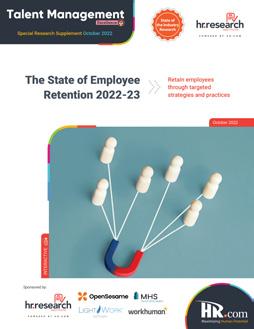
 - Brett Farmiloe, CEO & CHRO, Terkel.io
- Brett Farmiloe, CEO & CHRO, Terkel.io



The State of Employee Retention 2022-23 Page 25-44Sponsored by:
Themed Edition on Reskilling, Upskilling, and Retaining Talent in the Workforce OCTOBER 2022 • Vol. 09 • No. 10 (ISSN 2564-1972)
Talent
On the Cover
a
45 Retaining High Demand Talent In The United States

U.S.
the
Richa
How 18 Leaders are reskilling & Upskilling Their workforce
retention strategies to retain your top talent

Brett Farmiloe,
&
Terkel.io
To
Tech Team
must
An
in a
59 Approaching A Workforce Reduction When Bracing For A Recession
Jojo Benge,
President,
61 Don’t Forget About The Employee Side Of Pay Transparency
time
with your employees
state of
07inde X
Talent Management Excellence OCTOBER 2022 Vol.09 No.10
Valuable employee
-
CEO
CHRO,
(ISSN 2564-1972) 51 Going Global: How
Build
International
Companies
put themselves
stronger position to embrace a wider talent pool -
Gupta, Chief Human Resource Officer, G-P
There is no one-size fits all approach -
Vice
People and Strategy, Wurk
It’s
to reset the relationship
- Nancy Romanyshyn, Director, Pay Strategy & Partner Success, Syndio The
employee retention 2022-23 Page 25-44 Articles 18 How to Give Job Seekers with a Criminal Record
Fair Chance - Abbey Carlton, Indeed
The
can benefit tremendously by allowing talented immigrants to stay here - Sasha Ramani, Head, Corporate Strategy, MPOWER Financing SPONSORED ARTICLE Themed Edition on Reskilling, Upskilling, and Retaining
in
Workforce
Reskilling, Upskilling, And Retaining Talent In The Workforce

Improve core metrics quickly with better talent engagement


- Anil Dharni, Co-Founder and CEO, Sense
Top Picks 14 22
Why Should Organizations
Invest In Reskilling And Upskilling Now?
Here are 4 reasons
- Launia Terry, Vice President, Corporate Talent Acquisition, Yoh/Day & Zimmermann
The Importance Of Continually Asking Questions In Reskilling And Upskilling
4 ways we can model and promote the importance of life-long learning in our teams

- Jonathan H. Westover, Chair and Associate Professor, Organizational Leadership, Woodbury School of Business, Utah Valley University
47 56
What To Do About ‘Quiet Quitting’
3 top considerations for preventing employee burnout and managing through quiet quitting
- Joe Galvin, Chief Research Officer, Vistage Worldwide
INDEX
How are our Talent Management Products and Services helping to make you smarter?

Talent Management Excellence - Monthly Interactive Learning Journal
This monthly interactive learning experience captures key metrics and actionable items and keeps you focused on your Talent Management Needs.
Talent Management Webcasts for Credit
Talent Management Virtual Events

Talent Management Virtual Events will help individuals who deal with the different areas in talent management get a better understanding of the big picture of their organization. Manage performance and talent effectively by studying topics from compensation and incentives, technologies, and compliance to managing and tracking performance of an organization, a department, employee, or even the processes to build a product or service. Each Virtual Event consists of up to 10 credit webcasts.
HR.com webcasts deliver the latest Talent Management industry news, research trends, best practices and case studies directly to your desktop. Webcasts are available live online with a downloadable podcast and a copy of the slides (PDF) available before and after each webcast. Earn all of the required recertification credits for aPHR, PHR, SPHR, GPHR, and SHRM Certifications. HR.com’s one-hour webcasts, in every HR specialty including Talent Management, are pre-approved for HRCI and SHRM credit (excluding Demo webcasts).
Talent Management Community
Join almost 120,000 HR.com members with a similar interest and focus in the Talent Management Community. Share content and download research reports, blogs, and articles, network, and “follow” peers and have them “follow” you in a social network platform to communicate regularly and stay on top of the latest updates. This well established Talent Management Community is an invaluable resource for any HR professional or manager.
Use these invaluable Talent Management resources today! For more information phone: 1.877.472.6648 | email: sales@hr.com | www.hr.com
Editorial Purpose
Excellence Publications
Dawn Jeffers VP, Sales

Kelley
debbie Mcgrath Publisher, HR.com
ediTor’s noTe
Babitha Balakrishnan Editor, Talent Management Excellence

invest in employee development and Boost retention
With employees moving out or consciously making an effort to scale back their output at work, one thing is clear - employee disengagement is at its peak. Although organizations are taking up various measures to improve workplace culture, putting employees first and connecting their growth with that of the organization might actually help retain talent. Is reskilling and upskilling the way ahead?
Finding the right person for the right role, especially in a disruptive environment that increasingly demands higher-skilled workers, is getting more complex. Reskilling and upskilling an existing workforce is a quick and easy way to avoid skills gaps and costly talent deficits.
Employee development to engage and retain talent in the workforce today means investing in your talent across the talent engagement flywheel. What does that look like, exactly?
The October edition of Talent Management Excellence includes informative articles that focus on employee development strategies along with other employee engagement and retention approaches.
Terkel.io’s Brett Farmiloe, in his article, How 18 Leaders Are Reskilling & Upskilling Their Workforce, offers valuable strategies on reskilling and upskilling employees, as shared by organizational leaders.
More employees than ever are open to new opportunities, but that doesn’t mean they want to leave your company. Sense’s Anil Dharni shares in his article, Reskilling, Upskilling, And Retaining Talent In The Workforce, that upskilling opportunities are
an excellent way to build stronger talent relationships and get better productivity, creativity, and results from your team.
As quiet quitting, the silent killer of productivity & success is prevalent in today’s organizations, it is high time business leaders focus on increasing employee engagement and improving internal communication and trust. Vistage Worldwide’s Joe Galvin in his article, What To Do About ‘Quiet Quitting,’ highlights solutions for preventing employee burnout and managing through quiet quitting.
Also read, Launia Terry’s (Yoh/Day & Zimmermann), Why Should Organizations Invest In Reskilling And Upskilling Now? to learn why it’s important to adopt a reskilling and upskilling program to help fill existing talent gaps.
In brief, employees today have the opportunity to push back when they feel unmotivated, unappreciated, and overwhelmed, and they no longer will simply “push the pace” without reward or alignment. Organizations that invest in employees’ career development and growth will lead to engaged, high-per forming employees who would stay with a company longer.
We hope you find the articles in this issue informative and helpful and, as always, we welcome your valuable feedback and suggestions.
Happy Reading!
Disclaimer: The views, information, or opinions expressed in the Excellence ePublications are solely those of the authors and do not necessarily represent those of HR.com and its employees. Under no circumstances shall HR.com or its partners or affiliates be responsible or liable for any indirect or incidental damages arising out of these opinions and content.
OR For Advertising Opportunities, email: sales@hr.com Copyright © 2022 HR.com. No part of this publication may be reproduced or transmitted in any form without written permission from the publisher. Quotations must be credited.
Our mission is to promote personal and professional development based on constructive values, sound ethics, and timeless principles.
Debbie McGrath CEO, HR.com - Publisher
Sue
Director (Product, Marketing, and Research) Babitha Balakrishnan and Deepa Damodaran Excellence Publications Managers and Editors Talent Management Excellence (ISSN 2564-1972) Babitha Balakrishnan Editor Chinnavel Design and Layout (Digital Magazine) Chandra Shekar Magazine (Online Version) Submissions & Correspondence Please send any correspondence, articles, letters to the editor, and requests to reprint, republish, or excerpt articles to ePubEditors@hr.com For customer service, or information on products and services, call 1-877-472-6648 Talent Management Excellence is published monthly by HR.com Limited, 56 Malone Road, Jacksons Point, Ontario L0E 1L0 Internet Address: www.hr.com Subscribe now for $99 / year And get this magazine delivered to your inbox every month Become a Member Today to get it FREE! SIGN UP Write to the Editor at ePubEditors@hr.com
PUBLICATIONS?
In a world of unparalleled challenges (global pandemic, racial injustice, political rivalry, digital 4.0, emotional malaise), uncertainty reigns. Finding opportunity in this context requires harnessing uncertainty and harnessing starts with reliable, valid, timely, and useful information. The Excellence publications are a superb source of such information. The authors provide insights with impact that will guide thought and action.
Dave Ulrich
Rensis Likert Professor, Ross School of Business, University of Michigan Partner, The RBL Group

Excellence publications are my ‘go-to’ resource for contemporary and actionable information to improve leadership, engagement, results, and retention. Each edition offers rich and diverse perspectives for improving the employee experience and the workplace in general.



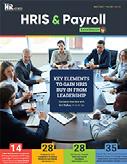
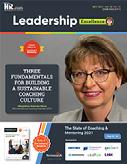
Julie Winkle Giulioni
Author, Virtual /Live Keynote Presenter, Inc.’s Top 100 Leadership Speakers
I regularly read and contribute to Leadership Excellence and Talent Management Excellence. I use many of the articles I read to augment my own presentations and I often share the articles with my clients. They are always quick, right on target for the latest issues in my field, and appreciated by my clients. If you want to stay up to date on the latest HR trends, choose a few of the different issues from the Excellence series of publications.


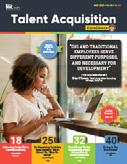

Dr. Beverly Kaye CEO, BevKaye&Co.


at ePubEditors@hr.com
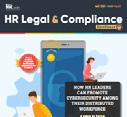



We’re eager to hear your feedback on our magazines. Let us know your thoughts
WHY EXCELLENCE
How 18 Leaders are reskilling & Upskilling Their workforce
Valuable employee retention strategies to retain your top talent
By Brett Farmiloe, Terkel.io
as an Hr leader, what strategy do you use to reskill & upskill employees in your organization?
To help you reskill and upskill employees in your organization, we asked CEOs and HR leaders this question for their best insights. From attending offset startup events to trying reverse mentoring within the organization, there are several strategies that you can implement to help reskill and upskill employees in your organization.

Here’s how 18 leaders are reskilling and upskilling their workforce:
● Attend Offsite Startup Events and Challenges
● Include Pre-employment Testing in Your HR Strategy
● Complete Stretch Assignments
● Encourage Employees to Explore Unique Projects
● Hire a Consultant to Lead a Project
● Host a Shadow Program
● Implement Daily Learning
● Keep Up With Training & Development
● Record Video-based Training Modules to Upskill Teams
● Set a Funding Budget for Upskilling Courses and Conferences
● Create Goals With Timeframes
● Suggest Productivityenhancing Websites
● Use AI-generated Data for Insight
● Gamify Upskilling to Create Engagement
● Upskill Through Job Role Rotations
● Organize Business Research Trips
● Take a Flexible and Personalised Approach
● Try Reverse Mentoring
Submit Your ArticlesTalent Management Excellence presented by HR.com October 2022 7
coVer arTicLe
attend offsite startup events and challenges
My team and I used to go to Startup Weekend events as a way to stretch our brains a bit, working on different projects, with different requirements, and other people. These were not required events, but we went to them as a team and got to know each other better through different challenges. We’d been inspired by one of our mentors to do this and I think it was one of the best ideas we explored. Not only did we have all of these new experiences, but we connected with others, built our confidence, and learned new skills. When we came back to the office, we were all inspired to do new things and bring those ideas to work with us. We’re now looking to do different kinds of workshops and classes to learn new things together, as a team.
Matthew Ramirez, Founder, Paraphrase Tool

include pre-employment Testing in Your Hr strategy
We use pre-employment testing to learn more about candidates well before they join the organization. The information gleaned from pre-hire assessment tools then helps us better decide where to concentrate our efforts for our employees. Thanks to this strategy, it has become much easier to upskill those with knowledge gaps to fill, and also to reskill those who’ve been promoted or are taking on additional duties.
Linda Scorzo, CEO, Hiring Indicators


complete stretch assignments
Stretch assignments are assignments that go beyond an employee’s existing level of skills and experience. They give employees the chance to learn on the job while giving them the confidence to take on new challenges. We have found them to be the most effective strategy for accelerating skill development. For stretch assignments to be a success, it is important that employees are given the training and support to develop the new skills they need to tackle the assignment. The best employees to pick for stretch assignments are those who will view them as opportunities for career development and will be motivated to do their best work.
Dean Kaplan, CEO, The Kaplan Group

encourage employees to explore Unique projects
One of the best ways to encourage employees to upskill and gain new knowledge is to allow them to work on projects outside of their regular job duties. When employees are given the opportunity to stretch their abilities and explore new areas, they can develop a greater understanding of their own strengths and weaknesses. Additionally, working on new projects can help employees to build essential skills such as problem-solving, adaptability, and creativity. Organizations that encourage employees to develop in new and exciting directions are more likely to retain and attract top talent. Furthermore, employees who are constantly learning and growing in new areas are often more engaged and productive. By encouraging employees to explore their own projects, organizations can ensure that they have a highly skilled and well-rounded workforce that is equipped to handle whatever challenges may arise.
Clare Jones, Marketing & HR Manager, OfficeSpaceAU
Submit Your ArticlesTalent Management Excellence presented by HR.com October 2022 8 How 18 Leaders Are Reskilling & Upskilling Their Workforce
Hire a consultant to Lead a project
When I want to upskill my team, I hire consultants to train and work alongside them on specific projects. Everything is transparent so that the consultant understands that their role is to improve my staff. I’ll generally do this on a per-project basis, where the consultant owns the deliverables and results. They lead the team, and my staff provides support. During this process, everyone is aware that the goal is for the team to be upskilled, so they’re expected to take notes and ask questions. At the end of the project, I’ll give the staff greater responsibility on the next one that comes up, to see how much they learned. Based on those results, I might repeat the process, or expand their responsibilities.
Dennis Consorte, Host, Snackable Solutions


Host a shadow program
Implement a shadow program. A great strategy we’ve found to reskill and upskill our employees is to have them shadow senior-level team members so that they can learn first-hand valuable lessons and tools and create a mentor-like relationship that can nurture their career goals.
For example, when a younger employee shadows a team leader in a new department they’re interested in, they can broaden their skills, test their interest in this new position, and develop a mentor-like relationship that can offer them ongoing guidance. There’s no better way for employees to learn new skills than by shadowing upper-level team members in your organization who can teach them the tricks of the trade first-hand and offer them a mentor-like relationship.
Karim Hachem, VP of eCommerce, Sunshine79
implement daily Learning
When I was in HR, I learned that the best way to upskill and reskill a team is to implement small, daily learning opportunities whenever possible. This avoids the downtime and brain drain of upskilling while applying education to daily tasks. Instead of two, five-hour workshops, for example, you break down the learning objectives across a longer period of time and relate them to tasks and processes that are already established. Humans are better able to learn new things if they can relate new information to old information, so this is a cornerstone of my approach. Gradually moving further away from the old skillset by building upon it rather than building a new skillset from scratch is slower, but more sustainable.
Volodymyr Shchegel, VP of Engineering, Clario

suggest productivity-enhancing websites
One thing I do to induce and increase the productivity of my workforce is by suggesting to them a wide number of business-oriented websites that are specially designed to cater to the corporate world. Web browser extensions like Tofeeshare, Grammarly, Wordtune editor, Hemmingway editor, and also applications like Slack and Discord can significantly reduce the hassle of communication and interaction, especially in hybrid work models. All these simple tweaks not only benefit the employees but in the grand scheme of things benefit the company enormously.
Kurt Uhlir, Chief Marketing Officer, kurtuhlir

Submit Your ArticlesTalent Management Excellence presented by HR.com October 2022 9
How 18 Leaders Are Reskilling & Upskilling Their Workforce
Are Reskilling & Upskilling Their Workforce
keep Up with Training & development
One common strategy is to offer training and development opportunities. This could include providing on-the-job training to sponsoring employees to attend conferences or take courses.
Another strategy is to create mentorship programs, pairing experienced employees with newer staff members. These programs provide an opportunity for knowledge transfer and help to build relationships between employees. HR departments can also use external resources, such as consultants or online learning platforms to supplement in-house training initiatives. By investing in employee development, HR departments can ensure that employees have the skills they need to be successful in their roles and contribute to the organization’s long-term success.
Wendy Makinson, HR Manager, Joloda Hydraroll


Set a Funding Budget for Upskilling Courses and Conferences
One of the strategies I use to reskill and upskill employees in my organization is providing opportunities for them to learn new things and grow their skill sets. Have a policy set up that allows employees to fund professional development opportunities, such as taking courses or attending conferences. You can have a set budget for each employee, or allow them to submit receipts for reimbursement. This will show employees that you are invested in their development and want them to succeed. You can also have a repository of resources that employees can access to learn new things on their own time. This can include books, articles, webinars, and more. By making these resources available, you’re giving employees the opportunity to learn at their own pace and in their own time.
Linda Shaffer, Chief People Operations Officer, Checkr
Record Video-based Training Modules to Upskill Employees
Create video training modules to upskill employees on programs, workflows, and industry expertise. Videos are easy to replicate to personalize your training by department or use while only needing to be successfully recorded once. With screen-recording technology, industry professionals can walk employees through a new program, database, or instructional series in a burgeoning field. This strategy is both cost and labor-effective while creating instructional content that can be replicated easily over time. These videos save businesses time and money that would be spent teaching classes, doing one-on-one training, or subsidizing private courses.
Jason Panzer, President, Hexclad

Submit Your ArticlesTalent Management Excellence presented by HR.com October 2022 10
How 18 Leaders
Create Goals With Timeframes
We offer our team members a growth mindset stipend to boost their learning and development. We differ from other companies in that we encourage accountability on three levels. To start, we meet with team members face-to-face to discuss their skill-upskilling goals. This helps them mentally prepare in advance, encouraging them to really think about what skill and how learning that skill will actually benefit their personal and professional lives. Nobody wants to devote their time to learning just something fancy over “serious” skills. Secondly, we provide a timeframe — one that is generous, but still a timeline. After that timeframe, we will often assign them new tasks so they can put their knowledge to work daily, along with commensurate perks. We want to ensure we all take upskilling and reskilling seriously and get it done in good time, given today’s rapid pace of change.
Jon Torres, CEO, Jon Torres

gamify Upskilling to create engagement
The best way to encourage upskilling in employees is to gamify it. In my company, we have access to Udemy Business. It’s $360/yr/employee so it’s not a lot of money, all things considered. We give employees 1 day per iteration to focus on a new skill. At the end of a quarter, employees give demos of the skills they learned. Then we vote on the best demos and the winners get to choose a prize. We offer Amazon gift cards, bonus PTO days, the right to choose catering on meeting days, etc. It’s a small monetary investment but it helps ensure that my employees keep up on the latest trends in IT which is the fastest changing and evolving sector without question.
Jeremy Clifford, Chief Executive Officer, RouterCtrl

Use ai-generated data for insight
Reskilling and upskilling employees require insight into the current employees’ skills. After scaling up their skills with data, it is easy to come up with the areas in their skill set that require more work than others. In fact, every phase of the learning process can benefit from the use of data to guide decision-making. AI systems may identify a worker’s skills gap and customize their learning experience by looking at their employment experience and career trajectory. It can also be used to find strategies to move groups of workers whose employment will be seriously disrupted into roles that are in demand. AI-generated data can be used in several other ways based on the organization’s needs to ensure the formulation of effective reskilling and upskilling strategies.
Deepa Tailor, Owner and Founder, Tailor Law

Submit Your ArticlesTalent Management Excellence presented by HR.com October 2022 11
How 18 Leaders Are Reskilling & Upskilling Their Workforce
Upskill Through Job role rotations
One of the best ways you can reskill & upskill your employees is by giving them the option to change their job roles. Every employee is interviewed on the basis of how they can add value to the company, but very few companies consider the opposite approach, ‘how to add value to our employees’. The best way to do this is by teaching your workforce a diverse set of skills and continuously evolving those skills. This strategy is very difficult if employees are limited by their job description and as such our company policy is to give all employees the option to change their job roles after a specific period of time. We have had marketing managers change their field to sales and find success and we have seen our sales team constantly rotate to the advertising division. This is why we at Car Donation Centers take great pride in our multi-talented workforce.
Mike Clancy, CEO, CarDonationCenters

organize Business research Trips
You can organize a business research trip for your employees to a different country or city where one of your biggest competitors or most admired companies is. You can visit the local market to experience the culture & can meet with a few famous business personalities, this will help your employees to grab knowledge through their surroundings and experience of successful people. If you go to a different country, it will help you to research a foreign market from a close view & it will bring eminent value to your team through real-life observation & learning. Business Research Trips can also become recreational for your team, which can help you fulfill two goals at once.
Roger Deutsch, CEO at Alcat-Europe, Alcat-Europe

Try reverse Mentoring
Our HR team came up with this effective idea of introducing reverse mentoring. Here, our senior staff is the one taking the learner role, and the new ones are in the teaching position. It’s not only flipping the roles but learning for the future. I say this because nowadays, a lot of tech-related opportunities and the market are understood by the current generation. This leaves the rest of the staff behind, who try to adjust the gap between their way of working and the current climate. The best way to avoid this is to merge the two factors. This way, all employees can turn tech-savvy and understand the current market needs. Another measure over here is learning from feedback sessions. It helps employees at both ends to come to a common ground. Learning isn’t only about honing new skills, but also gaining an understanding of how to work with the old ones. I feel our company has come a long way with this mentality.
Sally Johnson, CEO & Founder, Greenlightbooking

Submit Your ArticlesTalent Management Excellence presented by HR.com October 2022 12 How 18 Leaders Are Reskilling & Upskilling Their Workforce
Take a flexible and personalised approach

We recognize that every person has different needs, and therefore our internal L&D platform offers a wide range of learning methods. These include one-to-one coaching and mentoring sessions, workshops, and masterclasses on subjects from mental health and well-being to management and leadership, all offered on employees’ preferred days, time, and preferred ways of learning. We have a flexible learning time off policy, and we encourage employees to reach out to their managers to discuss training they would like to attend outside the L&D platform.

Paulina Bojaryn, HR Manager, Hugo & Cat
Would you like to comment?

Submit Your ArticlesTalent Management Excellence presented by HR.com October 2022 13 How 18 Leaders Are Reskilling & Upskilling Their Workforce
Brett Farmiloe is the Founder / CEO and currently the CHRO of Terkel.io
reskilling, Upskilling, and retaining Talent in The workforce
improve core metrics quickly with better talent engagement
By Anil Dharni, Sense
Employee engagement has taken a hit for the first time in a decade, dropping several points. We’re bombarded with buzzwords like “quiet quitting” that highlight just how disengaged folks really are during the workday. And in core industries like healthcare, the numbers are even more dire.
The situation seems bleak, but there are outliers. In fact, some organizations are actually thriving – with double the rate of engaged employees at 70%.
What’s the difference between organizations across the spectrum right now when it comes to employee engagement?
While turnover and recruiting are at critical junctures right now, particularly for high-demand industries like healthcare, there are certain elements that can dramatically impact retention, productivity/output and even recruiting that should rank highly in your priorities.
Put succinctly, employees want you to invest with them. Reskilling, upskilling, and retaining your talent in the workforce today means investing in your talent across the talent engagement flywheel. What does that look like, exactly?
It starts with “hello” (aka “the recruiting process”)
That’s right, you should be investing in your talent before they’ve even joined your workforce. You are setting expectations and building trust with talent from their first touchpoint with your company. That could be a social post, a job posting, or a phone call from a recruiter.
The recruiting process
Regardless of what and where it is, there should be strategy and intention behind every touchpoint. Areas to invest in talent throughout the recruiting process include:
● Answering their questions A chatbot can simplify this, create better candidate experiences by answering questions 24/7, and avoid adding workload to already-taxed recruiters.
● Educating job seekers - This is important not just in the requirements from the job description, but in the soft and hard skills needed to thrive in the position and company, plus presenting them with the future skills they may need to gain as the job evolves.
Submit Your ArticlesTalent Management Excellence presented by HR.com October 2022 14
Top pick
● Make it easy to apply - Write job postings that sell talent on the most critical components of your jobs, leverage technology that simplifies applications without adding unnecessary steps (because no one enjoys applying to jobs).
● Respect their time Talent is getting bombarded with interest from employers across industries and locations. Yet, a majority of candidates have had negative candidate experiences Respect candidates’ time with the aforementioned chatbots and clearer job postings. Communicate with them throughout the hiring process leveraging automation to keep them engaged and informed, without overburdening your recruiters. And eliminate unnecessary steps or interviews so you can make the right decision as quickly as possible.
reskilling
You’ve spent potentially thousands of dollars and countless hours to attract top talent. Yet, many
organizations simply send generic emails when candidates aren’t an exact fit for a position.
That’s literally throwing away money, time, and candidates.
In 2017, the McKinsey Global Institute estimated that as many as 375 million workers—or 14 percent of the global workforce—would have to switch occupations or acquire new skills by 2030 due to automation and artificial intelligence.
McKinsey also found that 87 percent of executives said they were experiencing skill gaps in the workforce or expected them within a few years. But less than half of the respondents had a clear sense of how to address the problem.
Reskilling is an essential part of the puzzle. You could leverage job-matching AI and automation to send silver medalists (candidates who were excellent but

Submit Your ArticlesTalent Management Excellence presented by HR.com October 2022 15
Reskilling, Upskilling, And Retaining Talent In The Workforce
not the right fit for specific jobs) relevant jobs and invitations to apply.
Alternatively, reskilling is increasingly popular with organizations that don’t want to lose those silver medalists to the competition. After all, coming in at #2 or #3 means that while talent isn’t right for that position, they were still strong enough to make it to the final stages. They can likely contribute elsewhere in your organization. Reskilling requires an investment on your part but increases trust and confidence in your company with talent. This then cascades into improved productivity, retention, and even referrals, yet again adding more talent to the top of your funnel.
Even seemingly innocuous changes to your recruiting process can send ripples across your talent engagement flywheel.
it continues Through Hiring and starting with Your company
Many companies invest in a better candidate experience, only to drop the ball when it comes to onboarding and the earliest days of employment. These are critical days that will establish employees’ opinions of your company. It’s a critical juncture in your ability to retain talent (plus attract new talent through employee referrals and WOM).
onboarding
Automation plays a tremendous role in onboarding as well. Texting a link to complete onboarding paperwork before Day 1 eases stress for talent before they begin
and prevents dropoff. It also saves your HR team considerable time and effort.
Benefits
Core benefits like healthcare, retirement savings, and family care continue to be important. While you may have discussed them during the hiring process, the details can get lost in the excitement of the hiring process and accepting a new job offer. Keeping new employees engaged and in the loop on benefits –even proactively sending them links to review and begin signing up for benefits – can help with opt-ins and reinforce your commitment to employees through your benefits program.
referrals
Another way to make employees feel valued and improve retention from Day 1? Ask them for referrals! Asking employees to refer more great people makes them feel important and valued. And if your organization has a competitive referral bonus structure, your likelihood of adding candidates to your funnel increases.
Like with any talent engagement across the talent engagement flywheel, it’s critical to keep processes here simple. The onboarding and benefits suggestions above simplify processes for both talent and employers. In many organizations, the referral program is an afterthought and can be convoluted, difficult to understand, or difficult to participate in at your organization. If you haven’t done a review of your program (and/or asked for employee feedback),

Submit Your ArticlesTalent Management Excellence presented by HR.com October 2022 16
Reskilling, Upskilling, And Retaining Talent In The Workforce
consider taking a fresh look at it before going all-in on a referral strategy.
Once you do have a tight referral process and strategy in place, automation can again simplify your referrals outreach to save time for overburdened HR departments and recruiters, while increasing results tremendously as we’ve seen here at Sense.
and should Be a fluid, ongoing investment in Your Talent
Many organizations go into autopilot once talent has been hired and onboarded. But this is where the biggest opportunity lies to improve retention and increase those referrals I just mentioned. And of course, the literal and productivity costs to replace employees are significantly higher than the cost to retain them.
communication
Effective communication is the top expectation employees have of employers in their organization. Yet, 63% of employees wish they heard from their company’s leadership more
Here at Sense, we hold biweekly company all-hands meetings, where we hear from every department on what’s going on in the organization. Our HR team sends out messages via email and Slack regularly, and we host virtual and in-person happy hours and more to provide opportunities for our team to connect and hear about what is happening within the company.
If your organization has not developed or implemented an internal communication strategy, now is the time to get on board.
Upskilling
The number of employers who felt professional development benefits were important to offer grew to 65 percent in 2022. More talent than ever is open to new opportunities, but that doesn’t mean they want to leave your company. I’ve already talked about how important it is to develop clear, concise processes and to make applying and benefits adoption easy for your employees.
Upskilling opportunities are an excellent way to build stronger talent relationships and get better productivity, creativity, and results from your team. Research from Udemy found that 38% of the workforce was being upskilled or reskilled in 2020. That’s an increase of 24% year over year, but it also shows just how much opportunity there is for organizations to step up.
Upskilling plays an integral role in helping define clear career paths and opportunities for your team. It builds confidence and trust in your organization, and as I mentioned, it can lead to significantly greater output.
How to put all of This into action
These are all tactical moves, investments in an ongoing talent engagement strategy. But they’re also cultural and should become ingrained in your organization. An easy way to get everyone onboard and involved with talent engagement (because in many ways, as you can see, talent engagement touches nearly every part of your company) is to properly leverage a robust talent engagement platform versus one-off point solutions, which can vary from department to department and create fractured talent experiences with your company.
Anil Dharni is the Co-founder and CEO of Sense, the leading AI-powered talent engagement and communication platform. Before founding Sense, Anil was co-founder and COO at Funzio, which was acquired by GREE in 2012 for $210M. Prior to Funzio, Anil led product and design at the third-largest Social Networking company, hi5. He is an international speaker and thought leader known for developing the best candidate engagement tools in recruiting.
Would you like to comment?

Submit Your ArticlesTalent Management Excellence presented by HR.com October 2022 17
Reskilling, Upskilling, And Retaining Talent In The Workforce
How to give Job seekers with a criminal record a fair chance

 By Abbey Carlton, Indeed
By Abbey Carlton, Indeed
As many as 100 million people in the US have a criminal record. That’s almost one in every three Americans. Job seekers who have been involved with the criminal legal system — or justice-impacted job seekers — want the same things that everyone else wants in life: the ability to provide for themselves and take care of the people they love. But many of them are barred from pursuing this
due to employment policies and hiring practices that discriminate against them. According to the Sentencing Project, an advocacy center for criminal justice reform, more than 60% of the formerly incarcerated are still unemployed a year after being released from prison.1 Securing employment to earn a living is one of the biggest challenges for those reentering society.
Moreover, given the racial disparities in the criminal legal system’s impact, these challenges are more pronounced for Black Americans. Since the killing of George Floyd and the subsequent racial reckoning in the US, large employers have expressed deeper commitments to racial equity and diversity in their hiring and retention practices.2 Dedicating to fair chance hiring is one of many ways to realize those employer commitments.
Submit Your ArticlesTalent Management Excellence presented by HR.com October 2022 18
sponsored arTicLe
Fair chance hiring is the act of giv ing fair consideration to all quali fied candidates regardless of their criminal record. It gives justice-im pacted job seekers a better shot at landing a job and improving their lives. And they aren’t the only ones who benefit. Companies that hire fair chance candidates are re warded with better retention rates and reduced rehiring costs as these candidates tend to be more loyal. A study from Northwestern University found that justice-im pacted candidates who were hired had a 13% lower turnover rate.3
Indeed has been committed to providing individuals with criminal records a fair chance at employment since the very beginning (Indeed’s first employee in 2004 was a justice-impacted engineer), and it’s a journey the company is still on. Most recently, fair chance hiring has become a key focus of Indeed’s Environmental, Social and Governance (ESG) commitment to help 30 million job seekers facing barriers get jobs by 2030 — with the goal of breaking down bias and barriers in the hiring process.

So how can employers promote fair chance hiring and connect to this overlooked talent pool? Here are a few places to begin.
1. address the fears Your company May Have around fair chance Hiring
Many misconceptions and fears about justice-impacted job seekers keep them from
accessing employment. Hiring managers might have concerns about corporate liability, workplace safety or a negative response from their employees. Research has shown that justice-impacted job seekers are no more likely to steal, harass or harm colleagues than any other worker. A recent Indeed commissioned survey found that 92% of employee respondents would be comfortable working alongside a coworker with a nonviolent criminal record and a single, isolated incident, and the majority (54%) said they would be comfortable working alongside a coworker with a violent criminal record including multiple incidents. Yet these unfounded fears or concerns persist.
“In my experience, when business leaders and hiring managers balk at hiring people with criminal histories, it is because fear and emotion override rational business considerations that would otherwise drive their decisionmaking around hiring, even though most people seem to believe in the idea of a second chance,” says Andrew Glazier, the president and CEO of Defy Ventures, a nonprofit that provides entrepreneurship training to those with criminal histories.
Unconscious bias at your company could be keeping you from hiring winning talent. An important step is to make an effort to explain to stakeholders what fair chance hiring is and why it matters. You can start by launching a conversation. (You
can read more about Indeed’s approach here.)
2. go Beyond #BanTheBox and Use this practice only as a starting point
According to the National Employment Law Project, 37 states have adopted “ban the box” policies,4 and this movement has been gaining steam for more than two decades. “Ban the box” refers to the check box commonly found on many job applications that ask applicants to indicate whether they’ve ever been convicted of a crime.
The goal of #BanTheBox policies is to delay any question about a criminal record to the later or final stages of the hiring process so that candidates can be evaluated solely on their abilities for the role. Instead of being immediately disqualified, this policy gives candidates with a criminal record an opportunity to be considered on the merits of their skills and capabilities.
However, to be clear, #BanTheBox is a bare minimum and a starting point. For example, as of last year, the federal government took an additional step by enacting a new law that prohibits federal contractors from asking about conviction records until after giving an applicant a preliminary job offer. This move toward true fair chance hiring goes further than #BanTheBox by regulating when and how employers can conduct background checks.
Submit Your ArticlesTalent Management Excellence presented by HR.com October 2022 19
How to Give Job Seekers with a Criminal Record a Fair Chance
3. Highlight Your commitment to Hiring Justice-impacted Job Seekers

Some job sites focus exclusively on connecting justice-impacted candidates with open jobs. Launched in 2018, the platform Honest Jobs is the country’s largest fair chance employment marketplace. Founder Harley Blakeman was driven to start the organization after his drug-related arrest as a teen left the honor student with few employment options. Today, Honest Jobs employs a 20-person team of mostly justice-impacted employees who connect participating employers with formerly incarcerated job seekers.
It’s also important to make it apparent and obvious to
potential candidates that you are committed to hiring justiceimpacted job seekers. Recently, for example, Indeed made its commitment more visible by adding purposeful language to all of its US-based job descriptions so that any potential candidate knows about our company’s commitment. It reads as follows: “We value diverse experiences, including those who have had prior contact with the criminal legal system. We are committed to providing individuals with criminal records, including formerly incarcerated individuals, a fair chance at employment.”
4. reassess and Update Your company’s Background check processes and policies

Overly aggressive background check algorithms can automatically filter out candidates
with any type of criminal record — regardless of whether it was a minor, nonviolent crime that happened decades ago or even an offense that may no longer be a crime in the state where the candidate lives, such as marijuana possession. Human resources professionals should examine the parameters they have set with their background check provider to make sure it’s not excluding candidates with arrests or convictions that don’t relate to the core duties of the job. Depending on the provider or technology you use, you may be able to adjust your background check features to be thoughtful about what actually matters and what is creating an artificial barrier.
Outside of your technology, you can also reconsider how you evaluate the results of back ground checks. For example,
Submit Your ArticlesTalent Management Excellence presented by HR.com October 2022 20
How to Give Job Seekers with a Criminal Record a Fair Chance
in 2015, Indeed updated its background check program to improve best practices for hiring justice-impacted job seekers.
One best practice is to evaluate candidates based on the follow ing considerations: nature of the crime, time when it was com mitted and nature of the job the candidate seeks. Indeed doesn’t look at anything related to crimi nal records until after making a conditional job offer to a candi date. This means candidates can be evaluated on their skills and abilities for the role.
5. work with partners who can Help You grow Your fair chance commitment
Many nonprofits and other organizations across the US focus on supporting justiceimpacted people. Look into opportunities to collaborate with local partners to source, hire and retain this quality talent. National nonprofits such as Jails to Jobs and the Center for Workforce
Inclusion focus on career training and job placement for the justiceimpacted. Indeed partners with the Center for Employment Opportunities and works closely with Banyan Labs, a software development company that teaches, trains and supports justice-impacted job seekers and helps them graduate into jobs through on-the-job training programs. Through Indeed’s collaboration, Indeed places developers who are graduates of Banyan Labs’ Persevere program, giving them immediate on-the-job experience.
Being a fair chance employer means implementing scalable practices like those listed above. “Just saying you are ‘open’ to hiring people with criminal histories is not the same as being a fair-chance employer,” says Glazier.
All people have the right to work. And tapping into the quality but the often-overlooked population of justice-impacted job seekers is good for employers. By adopting fair chance policies, employers can not only be part of the solution, they can find the ideal candidate for the job.
SOURCES
1. The Sentencing Project— Americans with Criminal Records
2. Corporate America’s $50 Billion Promise, The Washington Post, August 2021; Workplace Racial Equity Depends on Job Retention as Much as Job Hires to Achieve a Truly Diverse Workforce, World Economic Forum, May 2021
3. Should You Hire Someone with a Criminal Record?
4. National Employment Law Project—Ban the Box Toolkit
RESOURCES
● Society for Human Resource Management—Ban the Box: What Employers Need to Know
● Ban the Box: US Cities, Countries, and States Adopt Fair Hiring Policies
● Out of Prison & Out of Work: Unemployment among Formerly Incarcerated People
Abbey Carlton is Vice President of Social Impact for Indeed, the world’s top job site. In this role, Abbey leads Indeed’s global efforts to break down bias and barriers in hiring through product innovation, partnerships and community initiatives. Prior to joining Indeed, Abbey spent nearly a decade at The Rockefeller Foundation, where she led the Foundation’s efforts on jobs and economic opportunity. Under Abbey’s leadership, Rockefeller partnered with Fortune 500 companies, non-profits, federal and local governments, tech start ups and others to promote talent strategies that meet business objectives while improving the outcomes of workers who face barriers to employment.
Earlier in her career, Abbey held research and program management positions with New York University’s Institute for Education and Social Policy, the US Department of Labor, and the law firm Cravath, Swaine and Moore, LLP. She is a fellow with The Aspen Institute’s First Movers program, a member of the Workforce Matters Steering Committee, and a mentor through PhilanthropyNY’s Young Leaders program.
Would you like to comment?

Submit Your ArticlesTalent Management Excellence presented by HR.com October 2022 21
How to Give Job Seekers with a Criminal Record a Fair Chance
w hy should organizations invest in reskilling and Upskilling now?
Here are 4 reasons
By Launia Terry, Yoh/Day & Zimmermann
For many organizations, employee turnover has become one of the biggest threats to their long-term success and short- and medium-term productivity. The good news is that the Covid-19 pandemic, which fueled a spike in employee turnover across the board, is slowing down. The bad news is that turnover rates are not exactly following suit.
According to research from Gartner, total annual employee turnover in the U.S. is expected to jump by nearly 20 percent from pre-pandemic annual averages. While turnover may not be as high in the near future as some organizations have seen over the past two-plus years, employee flight remains a substantial risk for organizations of all sizes and across industries. To put that into perspective, a company with a workforce of around 10,000 employees, which typically sees a turnover rate of around 18 percent, would need to prepare for an additional 360 voluntary departures on top of what it would normally experience in any given year. Certainly, that’s a non-insignificant number of roles to fill in what is already one of the most challenging hiring environments in recent memory.
When it comes to fighting turnover, it is often a two-pronged battle. Overcoming the inevitable turnover that all organizations experience is one fight, but the second – and more worthwhile battle in the long run – is preventing turnover in the first place. It’s
a challenge that HR leaders and hiring managers have been struggling to solve for decades but especially since March 2020.
Part of the solution to the battle against turnover begins with trusting your company culture and investing in your current workforce through dedicated reskilling and upskilling programs.
what is reskilling?
Reskilling a workforce includes providing employees with new skill training programs, offering them opportunities to grow their experience in new areas or specialties, and encouraging them to acquire new certifications somewhat outside their current area of expertise. Reskilling enables employers to extract more value out of their current workforce by building more diverse individual skillsets. It also allows employers, once individuals have acquired these new skills, to move them around interchangeably within their organization to fill a more pressing need.
Additionally, reskilling shows employees that their organization sees a higher potential for them and is willing to help them achieve that potential by investing in new skill development. When an organization invests in its workforce in this way, it helps foster a culture where employees feel more engaged in their roles and are less likely to look elsewhere for work.
Submit Your ArticlesTalent Management Excellence presented by HR.com October 2022 22
Top pick
From providing training on new equipment or tools to encouraging and paying for employee leadership certifications, reskilling helps ensure that if there’s a role that needs to be filled, an existing workforce has the people in place to fill that gap competently. Reskilling properly means employers will not feel compelled to ask workers to take on a job for which they aren’t qualified, which often leads to higher levels of workplace stress and employee burnout.
what is Upskilling?
When reskilling provides employee growth and development opportunities on a horizontal skill plane, upskilling helps workers improve their skills vertically. More akin to traditional career growth, upskilling includes providing employees with leadership training, current skill expansion or advancement, and new tools that make job tasks easier or more streamlined.
Typically, upskilling is easier for an organization to pull off because the time it takes to absorb new vertical skills is shorter and more willingly embraced by employees. Because of that, it helps fill supervisory roles more quickly. However, upskilling may not be as impactful as reskilling when it comes to filling gaps across departments.

why should a company invest in reskilling and Upskilling now?
Most people who work in HR and talent management/ acquisition know the cost of losing an employee and having to find a replacement. While the Society
for Human Resource Management (SHRM) says, on average, companies spend approximately 6-9 months of an employee’s salary to replace them, some studies say it could be up to 3-4x a position’s salary. And with turnover expected to continue at a higher rate than in years past, those costs could end up being devastating to a company of any size.
So, why should a company invest in reskilling and upskilling to retain employees? Here are four reasons.
1. investing in Your people is easier and faster than Hiring from the outside Too many organizations today are already dealing with what we at Yoh and DZConneX call a talent deficit. A talent deficit is when employers fall behind on filling their open roles, leading to an ongoing cycle where open roles create unfilled and unpredictable talent gaps – and eventually burnt-out employees – which leads to even more gaps when resignations occur. These shortages create costs and inefficiencies in the talent acquisition and management process, significantly inhibiting strategic business growth.
As experts in recruitment and talent acquisition, we know that finding the right person for the right role, especially in an environment that increasingly demands higher-skilled workers, is getting more complex. Reskilling and upskilling an existing workforce is simpler and quicker than trying to fix a talent deficit with no plan for breaking that cycle.
Submit Your ArticlesTalent Management Excellence presented by HR.com October 2022 23 Why Should Organizations Invest In Reskilling And Upskilling Now?
Why Should Organizations Invest In Reskilling And Upskilling Now?
2. providing opportunities for growth and skill development Breeds company Loyalty
A majority of employees want to improve their professional skills and advance in their careers.
Research from PwC found that 77 percent of workers are ready to learn new skills or completely retrain, while 74 percent say upskilling is the personal responsibility of each worker.
Investing in a culture of continuous learning – and giving employees the time to reskill and upskill at their own pace during the workday – shows employees that their company cares about their growth. Giving people reskilling opportunities and allowing them to try new roles, responsibilities, and tasks that interest them helps prevent burnout and keeps workers more motivated. Additionally, a robust skill development program can also help with those ongoing recruitment efforts.
3. reskilling and Upskilling foster a culture of advancement and growth
Every company wants a workforce that is happier and more motivated. With a skill development program that helps employees see how the acquisition of new skills can advance their careers, organizations can foster a culture where more people have the desire to learn and grow. It can be a delicate balance, but providing reskilling and upskilling opportunities can be a motivating factor for workers. When they see the benefits of learning, employees are more likely to work harder and be more dedicated to the work they’re already doing.
4. creating a Talent development program Helps identify where True skills gaps Lie
Encouraging the workforce to build new skills or further enhance the skills they already possess has fairly self-evident benefits. By building more skills, people are more skilled. Simple enough. However, what happens when an employer discovers that its reskilling or upskilling efforts related to a specific position or competency just aren’t working? What if an employer finds out that there aren’t any internal tools available to develop a specific skill?
By creating a culture where workers are encouraged to build new skills that align with their interests or talents, an organization can more easily identify where investments in outside talent make the most sense. For example, if a skilled nursing facility is having difficulty training nurses on a specific treatment, it may show that instead of hiring more general nurses, talent acquisition efforts should instead switch to pursuing individuals who have expertise in that specific treatment and can train others on how to implement it.
The current hiring environment is unlikely to change anytime soon. Those organizations who are struggling to fill open roles and retain existing employees may not find any reprieve in the near future if they don’t shift their thinking. Today, it’s never been more important to adopt a reskilling and upskilling program to help fill existing talent gaps. Working with a talent specialist can help an organization see where these types of programs may work best and where greater investment in talent acquisition may be necessary.
Launia Terry is the Vice President of Corporate Talent Acquisition at Day & Zimmermann. In her role, Launia serves as the initial contact with job candidates who are looking for employment and helps connect them with new roles that fit their experience and skillset. She recruits individuals who have worked in the engineering, munitions, recruiting and defense industries.
Would you like to comment?

Submit Your ArticlesTalent Management Excellence presented by HR.com October 2022 24
The State of Employee Retention 2022-23


Retain employees through targeted strategies and practices



Sponsored by: Special Research Supplement October 2022 INTERACTIVE October 2022
RESEARCH REPORT SUMMARY
The State of Employee Retention 2022-23 Exclusive Study By The HR Research Institute


Survey conducted by: Sponsored by:



The Future of Talent Acquisition Is Fueled by Technology
By MHS
A Modern Performance Management Model
By Aaron Kinne, Workhuman
9 Ways to Use Performance Management to Retain Employees

By Izabella Mitchell, LightWork Software

The HR Research Institute, powered by HR.com, the world’s largest social network for Human Resources professionals, is a key part of our mandate to inform and educate today’s HR professionals. Over the past three years, the HR Research Institute has produced more than 85 exclusive primary research and state of the industry reports, along with corresponding infographics in many cases, based on the surveys of thousands of HR professionals. Each research report highlights current HR trends, benchmarks, and industry best practices. HR Research Institute Reports and Infographics are available online, and always free, at www.hr.com/featuredresearch

INDEX 27 ARTICLE
32 40 37
The State of Employee Retention 2022-23
Retain employees through targeted strategies and practices

 Exclusive Study By The HR Research Institute Sponsored by:
Exclusive Study By The HR Research Institute Sponsored by:


Despite concerns about the U.S. economy, employee retention remains a burning issue for most organizations in the United States. The latest U.S. government data shows that the unemployment rate is just 3.7% and that payroll employment grew by 315,000 jobs in August 2022, indicating that the demand for employees remains high. Another source indicates that worker resignation rates are at the second-highest level they’ve been over the last three years!
So, it’s little wonder that when the HR Research Institute asked 708 HR professionals about which issues would be especially important to their organizations over the next 12 months, the most common answer was, far and away, employee retention.
After all, high employee turnover can wreak havoc on businesses, leading to declines in supply, productivity, customer service, and profits. It is therefore essential for organizations to understand

STATE OF THE INDUSTRY RESEARCH27
what drives employee turnover and how they can manage it.
This report explores various aspects of employee turnover, including:
● strategic importance of employee retention in organizations today
● important trends affecting employee retention
● drivers of employee retention
● strategies used to retain employees
● practices that differentiate organizations with higher-quality retention practices from others
Retention Continues to Be a Key Issue in the U.S.
Although August 2021 saw the highest U.S. resignation rate of 2.6% over the last three years, the second highest resignation rate (2.3%) occurred in August 2022. This latest data is comparable to the resignation rates in the midst of the “Great Resignation” period. This indicates that resignation trends continue to be a major issue despite economic slowdowns amid inflation fears.
Employee Retention Has Become a Very High Priority
When asked how they would describe their organization’s retention approach, just 5% of respondents say it is “top-notch” and 30% say it can be described as “advanced.” The majority, however, say their organization’s retention approach is at the intermediate level or below.
A majority (77%) of HR professionals say employee retention is either among the top three (42%) or the top priority (35%) in their organization today. Given the extent of today’s retention issues, it is little
wonder that it has become an important priority among senior executives, too. About two-thirds say it is among the top three (39%) or the top priority (23%) among senior executives.
A Variety of Socioeconomic and Employment Trends Are Driving Turnover
Employees are increasingly seeking positive experiences at work. HR professionals are well aware of this trend, so it makes sense that this desire for better work experiences is one of the top two most widely cited external trends (both at 53%) having an impact on retention. The other widely cited factor is the desire for higher wages. Further, employees are often lured by the increase in opportunities outside their organizations (50%). 1
The Covid-19 pandemic brought an unprecedented change in employee attitudes. A majority (69%) of respondents say this change was brought about with a desire to improve mental health (e.g., stress and burnout). Over half say the desire to spend more time with loved ones (55%) and the needs of their children, elderly parents/relatives (54%) are influential in employee decisions.
Retention Practices and Strategies Tend to Be Multifaceted
In a bid to increase employee retention, many organizations have engaged in a number of total-reward-related strategies. However, only one strategy was selected by more than half of respondents: increased compensation rates (51%). About one-third of organizations have also expanded/improved benefits offerings, improved health coverage/benefits and offered stay/retention bonuses.
Survey Question: Of the following reasons to reconsider the role of work in one's life, which do you believe are most influential for the employees of your organization? (select all that apply)
To improve mental health (e.g., stress, burnout)
Desire to spend more time with loved ones
Needs of their children, elderly parents/relatives
Desire to spend more time on pursuits outside of work
Alternate source of income (e.g., star ted small-scale business)
Greater susceptibility to serious health risks (e.g., Covid-19)
Mismatch with the core values of the organization Physical challenges (e.g., "long Covid")
More than a quarter say a mismatch with the core values of the organization causes employees to reconsider the role of work in their lives
29 STATE OF THE INDUSTRY RESEARCH
0 10 20 30 40 50 60 70 80 69% 55% 54% 46% 31% 31% 26% 22%
Survey Question: Over the last year, which of the following compensation-related actions has your organization taken to improve employee retention? (select all that apply)
Increased compensation rates
Expanded/improved benefits offerings
Improved health coverage/benefits
Stay/retention bonuses
Star ted or improved tuition assistance
Star ted or improved work-from-home stipends
Improved retirement benefits
Improved insurance coverage
Star ted or improved reimbursing for gas usage
None of the above
Over a fifth say their organization has started or improved tuition assistance as a means to improve employee retention
To learn more about the research study, The State of Employee Retention 2022-23, we invite you to download and read the complete report today to learn how these outcomes, insights, and takeaways can be applied in your organization.
Read the Research ReportRead the Research Report

30 STATE OF THE INDUSTRY RESEARCH
0 10 20 30 40 50 60 51% 33% 32% 31% 21% 21% 20% 20% 20% 13%


The Future of Talent Acquisition Is Fueled by Technology
MHS
In August 2021 U.S. unemployment dropped to 5.4%. Despite ongoing waves of COVID-19 and its variants, more people are expected to re-enter the workforce as governments around the world cease providing financial relief linked to the pandemic.
Experts expect intense competition for talent, further exacerbating the difficulty of recruiting top-notch talent which has risen to our collective consciousness as “The Great Resignation.”
Recruiting specialists are gearing up their talent acquisition processes, priorities, and technologies, to keep their businesses running smoothly. To aid recruiting specialists in what may quickly become the single most critical role in their organizations, HR.com recently undertook a survey to get a snapshot of what talent acquisition looks like in its current state and what HR professionals think it will look like in the future.
The Future of Talent Acquisition survey (a sponsored partnership between MHS and HR.com) gathered 210 complete and partial responses from HR professionals in virtually every industry vertical. Respondents are located worldwide, but most of them reside in North America. The participants represent a broad cross-section of employers by number of employees, ranging from small businesses with fewer than 50 employees to
enterprises with 20,000+ employees. Questions for the survey were guided by an independent advisory board of talent acquisition experts, who we thank for their insights.
Taking a closer look at current trends and interesting predictions in talent acquisition
1. Few HR professionals give their organizations high marks in terms of the maturity of their talent acquisition functions.
● Only 18% percent say their talent acquisition function is advanced or top-notch.
● About half say their talent acquisition function is progressing whereas 29% say it is either improvisational or chaotic
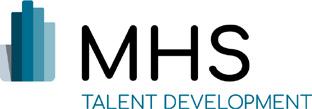
2. A wide variety of factors hinder and drive talent acquisition
●
The need to hire quickly is the most widely cited driver of talent acquisition efforts, at 63%, closely followed by the need to add enough workers to support growth, at 62%.
● The biggest barriers to talent acquisition success are not being able to find the talent that meets the job requirements (61%) and not having the right skills in the applicant pool (46%).
STATE OF THE INDUSTRY RESEARCH32
ARTICLE
3. Recruiting technologies are key to talent acquisition now and will become even more important in the future:

The most widely used and accessed technologies today are:
applicant tracking systems (ATS)
video interviewing technologies
referral systems and platforms
The technologies that will be most important to talent acquisition over the next three years are:
ATS
recruitment marketing platforms
assessments
remote, video-based hiring
4. Over the next three years, artificial intelligence (AI) will have the largest influence in four areas:
automating talent acquisition processes

targeting candidate searches
prioritizing resumes and applications
engaging candidates
5. Respondents say that over the next three years, three key talent acquisition goals will stand out:
maintaining a quality and engaged pool of possible candidates
staying as agile as possible to react quickly
cultivating a stronger employer brand
6. These four areas were identified as places where improvements will be most important:
more focus on quality candidates
more ability to source and hire diverse candidates
improved productivity and efficiency
more strategic talent acquisition that aligns with corporate goals
●
●
●
●
●
●
●
●
●
●
●
●
●
●
●
●
●
●
●
●
STATE OF THE INDUSTRY RESEARCH33 ARTICLE
Technology is driving change in the talent acquisition space

There are many recruiting technology applications available, most promising to increase the quality and quantity of candidates as well as recruiting efficiency. Categories include applicant tracking systems, candidate marketing systems, screening/ assessment tools, video interviewing platforms and onboarding tools, to name a few. Many of these applications have a long history and are updated regularly. Some, like employee referral systems, are newer on the scene.
Fifty-three percent of responding organizations report using an applicant tracking system. Other frequently used technology applications include video interviewing (41%), performance management (41%) and referral systems (39%). Given the increase in the need for remote-based hiring, it is not surprising to see a greater use of video interviewing technology than in the past.
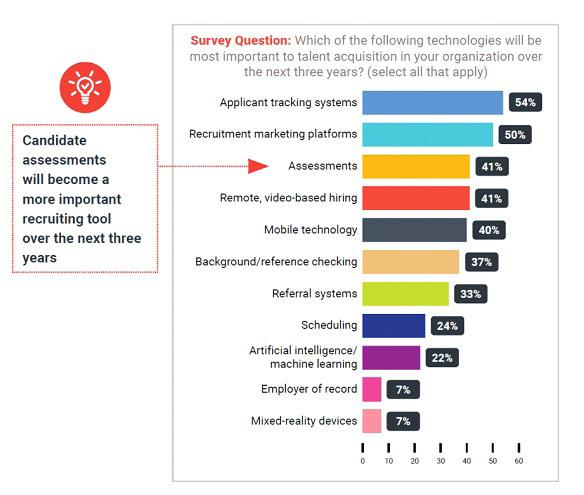
34 ARTICLE STATE OF THE INDUSTRY RESEARCH
Fifty-four percent say applicant tracking systems (ATS) will be among the most important technologies for talent acquisition over the next three years. This suggests that ATS will continue to be the backbone of many recruitment functions, enabling organizations to collect, organize and track candidates through the entire hiring process more easily.
Nearly as many respondents (50%) say recruitment marketing platforms will be important to talent management over the next three years. These platforms can allow organizations to better reach, attract and source qualified candidates. They can also help the organization measure the effectiveness of their sources and channels so that they can make more informed decisions about recruitment marketing strategies and budgets.
Finally, forty-one percent of respondents say candidate assessments will receive more importance in the future. Applicant testing and assessment tools have been around for decades, but it is only recently that they have become more automated, allowing organizations to administer validated skill-level and competency screens far more quickly and at a lower cost.
Ideas and tips for improving your current talent acquisition practices

Embrace new validated recruiting technologies when they can improve efficiency and effectiveness. Technologies will continue to evolve in this area. Newer applications include more robust job aggregators, predictive analytics using AI, online testing and assessments, video interviewing platforms, applicant management, and programmatic job advertising. As your organization
adopts new technologies, consider how they can best be integrated with one another. This will allow for better analytics and deeper insights into the recruitment process.
Prioritize both speed and quality. In the current labor market, employers must act quickly to hire good candidates. But quality is as important as speed. Great talent can improve productivity and efficiency in an organization. Identify current roles that did not exist or were unfilled within the past few years and illustrate how filling those positions with great hires promoted the ongoing growth and success of the organization. Such a narrative can form the basis of a compelling business case to make hiring the best talent a high priority. Organizations must find the best ways of balancing both speed and quality.
Establish clear goals for your recruiting efforts and measure them. Organizations that use a variety of metrics tend to have more effective recruiting systems. Without these metrics, recruiters are doing their jobs blindfolded, unable to get a handle on what is working and what is not. Compared to other HR systems, many recruiting metrics are easy to put in place (e.g., time to hire, retention, and source of hire). However, it is important to ensure a close link between the metric and the strategic goals of the organization. For example, a new start-up might require staffing up a large volume of hires in a short period of time. On the other hand, if you have a customer care team with extremely high turnover, longer-term retention might be the most critical metric. With clearly aligned goals, you can develop a data-based narrative about TA’s contribution to plans. TA can align with corporate goals in multiple ways. Higher sales might require additional skilled sales professionals.
STATE OF THE INDUSTRY RESEARCH
Developing new products might require hiring software developers, project managers and marketing professionals. Identify where and how successful recruitment furthers organizational and departmental goals and measure success against these efforts.
Upskill your recruiting team. The quality of your talent depends on the effectiveness of your recruiting function, and, in turn, your recruiting team. It is not an easy job. Effective recruiters need a host of behavioral competencies such as the ability to influence, attention to detail, excellent decision-making and more. But they must also master a host of other skills such as marketing ability, tech-savviness, data fluency, and strategic thinking. Given the importance of this role, take a close look at the strengths and development needs of your team and provide support to close the skill gaps. Consider partnering with your organization’s learning and development department to enhance current skills or train for new recruitment skills.
Evaluate where and how you find your best employees. Identify your best employees and find out where your recruiters found them. How can you engage similar candidates in the recruitment process? Do all your quality hires come from the same source? Tap into the sourcing channels that raise the odds of finding your next great hires and consider using new approaches, such as programmatic advertising. However, remember you may have to recruit in multiple channels depending upon the talent needed.
Audit the current skills within your organization. Compare your organization’s current in-house skills to the ones currently required and to the
skills you will need three years from now. Where are the gaps? Do you anticipate creating new roles to address innovation, growth, new markets, new products, or meet competitive challenges? Do you have employees who have proven their ability to learn and master new skills and technologies? Once you understand the gaps between what skills your organization has and the skills your organization will need, you can develop strategic talent acquisition goals to recruit the right talent to fill those skill gaps.
Learn more about MHS’ Talent Development solutions including our wide range of tools to help you with your talent acquisition process.

About MHS Assessments
For over 35 years, MHS has provided trusted data-driven solutions across our core disciplines: Clinical, Education, Talent Development, and Public Safety. Science and research are the basis of MHS’s roots and future innovations. With new standards for toolsets, we help clients evaluate, track, and leverage human-centric data to help realize full potential. We are guided by a clearly articulated digital trust framework to ensure that the rights and privacy of our clients are always protected. We strive for fairness and equity in the development and deployment of the products we make, the solutions we provide, and in the people we lead.
Would you like to comment?
9 Ways to Use Performance Management to Retain Employees
 Izabella Mitchell, LightWork Software
Izabella Mitchell, LightWork Software

Many corporations are no stranger to The Great Resignation as the United States experienced a 20-year high in its “Quit Rate” in November of 2021. Employees everywhere have expressed dissatisfaction with their jobs for many reasons, the main ones being wage stagnation throughout ever-increasing living costs and a desire for more remote or hybrid work options. 41% of employees are at least considering finding a new job, and 46% are more than happy to make a major career change to find something better.
Avoiding a similar outcome in your company is not an easy feat, but one that should at least be attempted. By giving them a sense of value and motivation, businesses can retain employees and increase satisfaction and productivity. Recognize employees and deliver meaningful and well-timed feedback to help them learn and grow, not only professionally, but in their personal lives as well. Read the infographic below to learn some ways you can use performance management to retain employees.
STATE OF THE INDUSTRY RESEARCH37 ARTICLE
If your company is not currently using a performance management system or your software is outdated, it can increase employee frustration. Having no regulated or scheduled performance reviews can make employees feel undervalued and unsure of where they stand: if they don’t know that they’re doing a good job, do you? Additionally, having a constant flow of communication between employees and their higher-ups can improve processes, provide better efficiency, and employees feel more satisfied because they know they can talk about and resolve their frustrations with current business practices. By implementing a performance management system like LightWork Software, the overwhelming task of managing employees is transformed into something to look forward to.
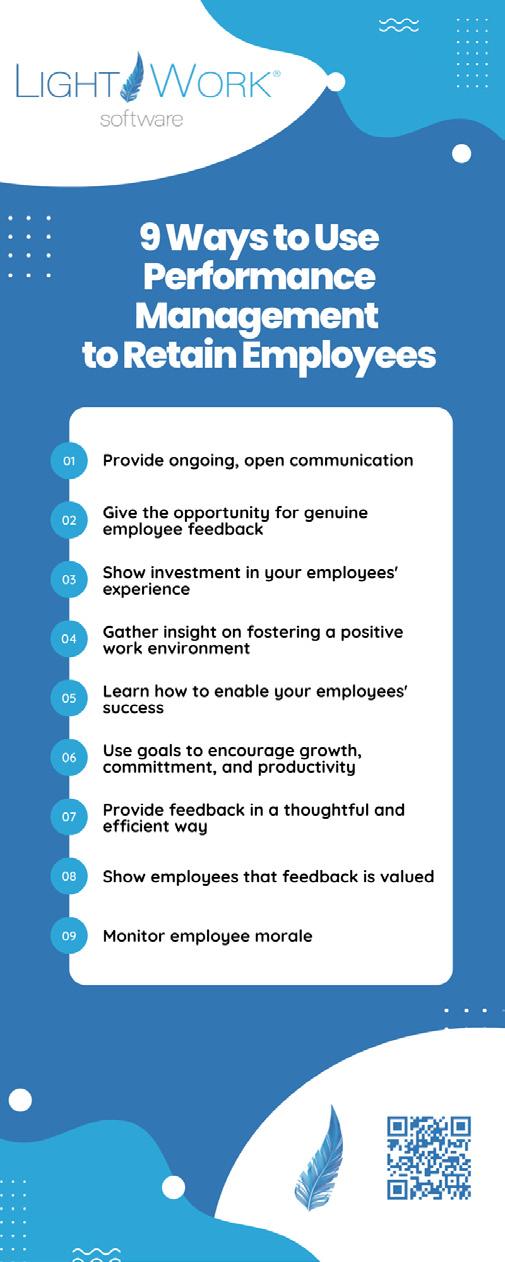
Want to learn about all the ways Performance Management can help you retain employees throughout the Great Resignation? Read more about all of our awesome features and tools on our LightWork Performance Management page!

Izabella (Izzy) Mitchell is a Marketing and Client Care Coordinator for LightWork Software. She handles internal employee communication and wellness, as well as advocating for all LightWork clients to receive the quickest and stress-free support possible. Ensuring the best work environment for her coworkers to succeed in and coordinating an inviting customer experience is her cup of tea. Izzy has worked in customer experience for a decade, and strives to use that experience in both employee and manager roles to connect the dots for human resource professionals to provide a healthy and wholesome company culture.
Would you like to comment?

STATE OF THE INDUSTRY RESEARCH38 ARTICLE

A Modern Performance Management Model: How Organon Reimagined Their Framework For Success
Let’s face it: No one is happy with the annual performance review. Not the employee. Not the manager. Not even human resources.
That’s because the traditional performance appraisal is based on an antiquated notion that a manager – someone who may not be fully aware of what the employee even does on a day-to-day basis – can inspire and coach a worker to new heights of engagement and productivity by meeting once or twice a year.

For decades, the performance management cycle has been the same. Each year, the manager sits down with the employee and
explains what the worker has done right or wrong. If the employee is lucky, she gets a pay increase. And if she is called into the boss’s office at any other time of year, it is usually because something is wrong – not a great formula for fostering employee motivation.
That’s why Organon wanted to break the mold on performance reviews. “We didn’t want a very heavy process that was about timelines, ratings, and labels,” noted Organon Vice President of Talent and Diversity Iris Melendez. “We wanted a process that was about people; that was about enabling our values and our culture.”

Enter continuous performance management
Most traditional approaches to performance management include prescribed, formulaic stages or steps that define the cycle. But Organon recognized that the way work gets done has changed, so they asked the question: Shouldn’t the way we manage performance and develop careers evolve too?
The debate isn’t about whether the traditional, isolated annual performance evaluation is effective – it isn’t. It’s about how to replace or supplement it, and with what.
That’s where a continuous performance management system comes in.
Organon recognized that continuous performance management is a modern, humancentered approach to promote, evaluate, and improve employee performance. It enables an organization to create a trusted environment in which employees feel empowered to take control of their own development and to create a culture where people are comfortable giving feedback up, down, and across an organization.
Employee development based on recognition
As Organon demonstrated, an effective performance management strategy begins with a foundation of trust and gratitude, generated through a strategic, comprehensive employee recognition program.
At Organon, they drew upon Merck’s highly successful recognition program, based on the
Workhuman® platform. According to Ashley Holland, vice president of rewards and HR solutions at Organon: “We really wanted to leverage the strong culture of recognition we had at Merck, but also build upon it and make it our own. And we did that by linking to our values.”
Celebrating employeesboth at and outside of work
The company also saw an opportunity to expand the program.
“Part of the Workhuman Cloud® is having these moments of connection where – whether the celebration is because I just bought a new home, or I had a birthday, or I got promoted
“Our founders have lives that go beyond the workplace. ‘Celebrate’ is a way for us to acknowledge all the important moments that they have going on in their lives.”
Ashley Holland, Vice President, Rewards and HR Solutions, Organon Rewards and HR Solutions, Organon
– it’s surfacing these moments that make it possible for me and my colleagues to get a greater connection,” said Rosette Cataldo, vice president of performance and talent strategy at Workhuman.
What an effective performance management model looks like
At Organon, performance management isn’t something that managers “do.” “It’s the founders [employees] who decide when it is time to have a check-in,” explained Iris, rather than following the timeline of human resources. “When do I feel like I need that feedback? How often? The founder is empowered to make those decisions to seek feedback from the people they interact with at work.”
The beauty of such a performance management model is that it creates a culture of psychological safety and trust in which employees support each other with twoway feedback that’s celebratory, instructive, and constructive.
“When you put the founder at the center, it creates more psychological safety in which I’m more receptive to feedback because I have requested it,” adds Iris. “That’s the biggest difference for us – the founders own it.”
On the employee experience

Because Organon has implemented the entire Workhuman Cloud – recognition, performance management, and life events and community celebrations – they are able to deliver a more unified and positive employee experience.
“Your employees don’t care about how you’re structured,” explained Iris. “They don’t care about how the HR team is set up, and who’s responsible for what. It’s one experience for them at the end of the day … If I was trying to promote a continuous cycle of feedback and check-ins — but we had an annual compensation process — that would be a real disconnect. That would be like driving with one foot on the gas, and one foot on the brake.”
On culture
Organon’s CEO and executive team “wanted to be very intentional about the type of culture we were building for Organon,” recalled Iris. “They were working on it for years, defining the values and culture of the company … We really were able to act as change agents to create the type of culture that the business leaders wanted for Organon. And that’s why we were designing the way we are – because we know that culture is really shaped greatly by the performance management process.”
Learn more Would you like to comment?
Aaron Kinne is a senior writer at Workhuman.
Stop managing. Start developing.
better engagement with proven performance


Drive
management strategies. Learn more

The State of Employee Retention 2022-23 Talent Management Excellence October 2022 For more information: 1.877.472.6648 sales@hr.com www.HR.com/epubs The HR Research Institute tracks human resources trends and best practices. Learn more at hr.com/featuredresearch
retaining High demand Talent in The United states
By Sasha Ramani, MPOWER Financing
Recently, Brad Chattergoon announced on Twitter that despite earning his degree in the U.S., he is seeking employment in other locations such as Canada and Australia. Why isn’t he looking to continue his career in the U.S.? The Harvard, Yale, and Caltecheducated data scientist was not selected in the U.S. H1-B visa lottery, and will take his valuable skills and experience abroad rather than contribute to the American economy.
Brad’s story is common. International students earn about a quarter of all science, technology, engineering, and mathematics (STEM) degrees
issued by American universities, and pursue STEM fields at significantly higher rates than their American counterparts. Even though these graduates are highly coveted by American employers, student visas only allow them to stay in the U.S. for up to three years after graduating.
We should strive to support skilled graduates like Brad by enabling them to stay in the United States, especially when they can meet a critical need or gap in our local economy. An analysis by the National Foundation for American Policy found that the majority of billion-dollar American firms were founded

Submit Your ArticlesTalent Management Excellence presented by HR.com October 2022 45
The U.S. can benefit tremendously by allowing talented immigrants to stay here
Retaining High Demand Talent In The United States
or co-founded by immigrants or their children and that more than 75% of American unicorns (privately held billion-dollar firms) were either founded by an immigrant or currently have an immigrant in a key leadership role. This includes the founders and leaders of famous U.S. tech companies, such as Sundar Pichai (CEO of Alphabet, Google’s parent company), Elon Musk (CEO of Tesla and SpaceX), and Satya Nadella (CEO of Microsoft), who combined their ambition and skills to create and lead successful companies.
In our current labor shortage, reforming immigration is vital to overcoming supply shortages in several sectors and in mitigating inflation. Though the U.S. labor shortage has touched and affected every industry, technology fields have been hit particularly hard. This trend was exacerbated by the effects of the Covid-19 pandemic, which further limited American firms’ access to skilled foreign workers.
The United States has the opportunity to learn from other countries that have considered more flexible paths to success for talented data scientists like Brad. The United Kingdom offers a High Potential Individual visa stream that allows graduates from the top 50 non-British universities worldwide to stay and work in the United Kingdom, and Canada’s Express Entry allows skilled professionals to receive an invitation to apply for Canadian permanent residence. In the United Arab Emirates, a Golden Visa enables graduates of the world’s top 100 universities to apply for a long-term (up to 10 year) visa, while Taiwan offers a Gold Card program designed to attract experts in key fields (including science and technology) and Singapore recently launched a similar Overseas Networks and Expertise pass. In each of these programs, the candidate has the option to renew their visa or apply for permanent residence immediately thereafter.
With so many other countries trying to attract the Brads of the world, the U.S. will fundamentally be unable to attract and retain global talent without immigration reform. The United States should work to celebrate, retain, and attract skilled graduates
of our universities, like Brad, enabling their talents, abilities, and skills to be integrated into our economy.
To start, the U.S. should increase immigration streams, visa quotas, and visa lengths for skilled workers and graduates of American universities— especially those with high-demand STEM skills. This would give American tech giants and other key industries the access and ability to hire the brightest minds from around the world.
Employers don’t have to scour the world to find its brightest minds - over a million of them are currently on American college and university campuses. To create a more seamless path from graduate programs to U.S. employment, Congress should extend the duration of Optional Practical Training (OPT) and Curricular Practical Training (CPT) for international students, and exempt those with in-demand STEM degrees from Green Card caps and the H1-B lottery. Removing randomness from deciding who gets to stay in the U.S. would be a substantial improvement and enables more strategic decisions about our economic and immigration policies.
These crucial changes to our immigration system would be exponentially beneficial to the United States and would position us to mitigate gaps in numerous key industries. We need Brad and his classmates here - so let’s find a way to keep them.
Sasha Ramani is the Head of Corporate Strategy for MPOWER Financing, a Public Benefit Corporation that offers scholarships and no-cosigner loans to international students coming to the United States and Canada.
Would you like to comment?

Submit Your ArticlesTalent Management Excellence presented by HR.com October 2022 46
The importance of continually asking Questions in reskilling and Upskilling
By Jonathan H. Westover, Ph.D. Utah Valley University
Iwas a curious child and always enjoyed learning. I was fascinated by the seemingly endless amount of knowledge out there and was so excited every time I learned a new mathematical principle or scientific law or theory. I felt like I was uncovering the mysteries of the universe! My teachers and parents encouraged questions and pushed me to try to better understand the way things work.
At some point, learning started to become a bit less magical for me; perhaps it was a function of my angsty teenage years, or perhaps it was the emphasis on conformity that I felt at home, church, school, and work. I was increasingly expected to follow often conflicting social norms within different contexts, and while curiosity was still “encouraged” in words, it also seemed like questioning was often punished in some way, even if passively or indirectly. The result was that some of my intrinsic motivation to learn started to dissipate and I played it safe. Do what the teacher, boss or parent says, in the way they want; to challenge or question, even with good intentions, often resulted in frustration and disappointment.
Fortunately, college shook me out of my intellectual stupor, ignited my inner rebel and helped me to rediscover the joy of learning. I also quickly realized how important continuous curiosity is, how dangerous certainty and arrogance can be and the vital role of intellectual humility in leadership.
why asking Questions is critical to Leadership success
Among the many leadership competencies and capabilities needed in an increasingly complex and interconnected global economy, we need leaders who are endlessly curious and insatiable when it comes to their ongoing learning; and that learning only happens when we relentlessly ask questions. Additionally, in a recent HBR article, the author states: “Questioning is a uniquely powerful tool for unlocking value in organizations: It spurs learning and the exchange of ideas, it fuels innovation and performance improvement, it builds rapport and trust among team members. And it can mitigate business risk by uncovering unforeseen pitfalls and hazards.”
Submit Your ArticlesTalent Management Excellence presented by HR.com October 2022 47
4 ways we can model and promote the importance of life-long learning in our teams
Top pick
Unlocking the potential of our people and the value in the organization is the core role and purpose of a leader, and as we ask questions, we can uncover challenges, increase our capacity for innovation and growth and ultimately produce better solutions and provide more value to the market. As we become more comfortable with challenging the facade of certainty, leaning into the nuance and messiness inherent to leading and managing people and asking questions, our organization will be better equipped to thrive in these complex and ever-shifting times.
The importance of continual Life-Long Learning
Curiosity leads to continual growth and learning, which drives positive personal, team and organizational outcomes. Below are four ways we can model and promote the importance of life-long learning in our teams.

stay curious with a growth Mindset and Leverage an abundance Mindset
Life-long learning is all about leveraging the many opportunities around us for continual growth and development. When we have a growth mindset, we see every experience (including the disappointments,
setbacks, and failures) as an opportunity to learn and develop our personal and professional competencies and capabilities. When we foster an abundance mindset, we don’t allow limited time and resources to hold us back; these limitations simply provide an opportunity for creativity, innovation, and growth. Together, growth and abundance mindsets create the firm foundation for sustainable life-long learning.
challenge assumptions and check Your Biases
We all know we have biases that we need to overcome, but how can we go about proactively challenging our assumptions and keeping our biases in check if we don’t recognize them? While there is no quick and easy solution, it also isn’t that complicated. We need to practice regular self-reflection, surround ourselves with differences (so we don’t get trapped in an echo chamber and our ideas can be challenged) and continually ask ourselves questions to get to the core of the issues we encounter (e.g., Why does that policy, practice or procedure exist? Does that system still serve its original purpose, with the desired equitable outcomes? Are we reinforcing the kind of healthy workplace culture we desire?).
Submit Your ArticlesTalent Management Excellence presented by HR.com October 2022 48
The Importance Of Continually Asking Questions In Reskilling And Upskilling
create a psychologically safe environment
Continual learning can’t happen if we don’t first create and sustain a psychologically safe workplace. We need to develop trust and help each employee understand that their unique perspective is needed. When a member of the team tries something and it doesn’t quite work out the way they had planned, avoid the temptation to respond in a punitive manner.
When we do that, we instantly create a chilling effect on creativity and will send a clear signal to the rest of the team that mistakes (learning) are not tolerated.
When our people don’t feel that it is safe to fail, they will tend toward self-protection and avoid rocking the boat, and innovation will be halted.
promote a speak-Up and Questioning culture

If we really feel that asking questions is essential to the health of the organization, we also need to promote a speak-up culture; otherwise, questions won’t be asked. We need to actively encourage our people to vocally question and challenge the status quo, existing organizational and team norms and even our own leadership approach. Our people need to know that we deem all feedback to be valuable feedback, even when we may disagree and especially when they notice something we may have missed. We can’t expect our people to have the courage to challenge us and the organization if we don’t model consistently speaking up and speaking out.
conclusion
Intellectual humility is an essential characteristic of effective and impactful leadership. Certainty is a facade, and unless we foster curiosity and continually ask questions, our teams and organizations will stagnate and innovation and productivity will suffer. As we foster a growth and abundance mindset and create a psychologically safe environment where our people can speak up and challenge the status quo — and where checking biases and asking questions is actively encouraged — our organizations will thrive.
Jonathan H. Westover, Ph.D., MPA, SFHEA, AFCIPD is Chair and Associate Professor of Organizational Leadership in the Woodbury School of Business (UVU), Academic Director of the UVU Center for Social Impact and the UVU SIMLab, and Faculty Fellow for Ethics in Public Life (previously the Associate Director) in the Center for the Study of Ethics. He is also an experienced OD/ HR/Leadership consultant (Human Capital Innovations, LLC), with experience transforming organizations across the globe.
Would you like to comment?

Submit Your ArticlesTalent Management Excellence presented by HR.com October 2022 49
The Importance Of Continually Asking Questions In Reskilling And Upskilling

epublication editorialcalendar2022-23 Checkoutthenewandupcomingthemed HRtopicsinTalentManagementExcellence. Check ePublications Editorial Calendar Here. Would you like to submit an article? | Write to us at ePubEditors@hr.com Submission Guidelines 1 Workplace Training and Development Sep 2022 2 Internal Mobility, Succession, and Career Development Nov 2022 3 Talent Management Trends 2023 Dec 2022 4 Addressing Talent Shortages in 2023 Jan 2023
going global: How To Build an international Tech Team
companies must put themselves in a stronger position to embrace a wider talent pool
By Richa Gupta, Globalization Partners
Going global is an objective where tech organizations risk falling short, not least because of the significant changes that can accompany corporate expansion, but also including additional financial and legal obligations. While there are certainly hurdles to overcome, establishing a local presence in selected regions throughout the world is more crucial today than ever for ambitious businesses
focused on expansion and access to talent. That’s why the right partner with the right technology is essential to winning market share and the competition for employees.
Building a diverse team with an in-depth understanding of local business environments, legislation, and regulations is crucial for any tech

Submit Your ArticlesTalent Management Excellence presented by HR.com October 2022 51
Going Global: How To Build An International Tech Team
firm that wants to succeed beyond its home market. Putting the right foundations and processes in place is vital and generally requires a team or individual tasked with the role of championing the global growth journey, and who has the skills to manage risks and opportunities in a foreign setting.
On a practical level, purpose-built technology can now offer an ideal platform for crucial processes, such as onboarding international candidates and managing a completely compliant worldwide payroll. This should form part of a holistic strategy so that businesses can embrace the full range of benefits associated with successful international expansion. In doing so, there are several foundational requirements that can help ensure success:
improve Talent acquisition
Tech organizations everywhere are competing to find suitable candidates with exceptional abilities or workers with specialized knowledge and experience. Those who succeed in breaking down existing, self-imposed barriers to international recruitment immediately gain access to a much wider talent pool with all the benefits that brings.
Indeed, any contemporary company that promotes itself as a diverse employer must embrace the cultures, philosophies and conventions that international candidates and employees offer. In doing so, not only do they address resourcing challenges, but also workplace culture often improves, serving as a powerful message when recruiting additional staff and attracting new customers.
draw on the digital Transformation of global growth
International tech hiring relies on an in-depth knowledge of the laws in the host country. This entails being up-to-date on issues as diverse as tax law, employment regulations, labor laws and crossborder compliance. Building this skillset is a long-term investment that’s key for any business that wants to manage its global staff remotely.
Today, global employment platforms powered by AI are available to assist in creating a seamless, singular experience, integrating team members from different geographies. In fact, the right global employment platform supplier can enable organizations to expand into new markets and establish a local presence

Submit Your ArticlesTalent Management Excellence presented by HR.com October 2022 52
anywhere in the world, from hiring global personnel to managing compliance and payroll. This ‘digital transformation’ of global growth is opening up new possibilities for businesses everywhere that may have previously seen international expansion as beyond their capabilities and resources.
embrace remote and flexible working
As the “Great Resignation” left its impact, 2022 was described as a “watershed point for organizational culture” by LinkedIn’s Global Talent Trends report. It points out that in an era of change unseen in living memory, employees reevaluated their professional objectives, such as work-life flexibility and benefits that support it, as well as their career ambitions and life values.
As a result, “technology business leaders are rethinking their entire working models, cultures, and company values. Employees, too, are rethinking not just how they work, but why,” according to LinkedIn CEO Ryan Roslansky. It’s perhaps unsurprising,

therefore, that LinkedIn members posted more about these key topics in 2021, compared to 2019. Specifically, flexible work saw a 362% increase, wellbeing, a 35% increase, and company culture was up by 15%.

This helps explain why more tech firms are beginning to embrace flexible working arrangements permanently. As this way of working becomes the new standard, more businesses will be able to hire people from other countries, drawing on intelligent, AI-driven technology to deliver on their objectives.
With international expansion rising up the agenda of more tech organizations worldwide, companies must put themselves in a stronger position to embrace a wider talent pool, draw on the benefits of digital transformation and build flexibility into their workplace culture. Those that do so will be ideally placed to compete on the global stage to translate domestic success into sustained international growth.
As Chief Human Resource Officer at G-P, Richa Gupta leads all facets of the global workforce, while playing a key strategic role in scaling the company and culture to meet the surging demands of remote work across the globe. She’s been in Human Resources for the last two decades helping organizations create and unlock their talent practices, build strong global companies with a purpose, lead highperforming teams, curate workplaces for talent to thrive, and develop strong and empathetic leadership muscle.
Would you like to comment?
Submit Your ArticlesTalent Management Excellence presented by HR.com October 2022 53
Going Global: How To Build
An International Tech
Team
CERTIFICATION PREP COURSES
GROUP RATES AVAILABLE
For HR Professionals
Show that management values the importance of the HR function, and has a commitment to development and improvement of HR staff.
Ensure that each person in your HR department has a standard and consistent understanding of policies, procedures, and regulations.
Place your HR team in a certification program as a rewarding team building achievement.
For Your Organization
Certified HR professionals help companies avoid risk by understanding compliance, laws, and regulations to properly manage your workforce.
HR Professionals lead employee engagement and development programs saving the company money through lower turnover and greater productivity and engagement.
A skilled HR professional can track important KPIs for the organization to make a major impact on strategic decisions and objectives, including: succession planning, staffing, and forecasting.
HRCI® & SHRM®
HR.com/prepcourse CALL TODAY TO FIND OUT MORE 1.877.472.6648 ext. 3 | sales@hr.com

1 Less expensive than a masters or PhD program, and very manageable to prepare with 2. legislation and best practices 3. Recognized, Industry benchmark, held by 500,000+ HR Professionals We offer group rates for teams of 5+ or more for our regularly scheduled PHR/SPHR/ SHRM or aPHR courses. For groups of 12+, we can design a more customized experience that meets your overall length of the course. Groups rates for HRCI exams are also available as an add-on. All group purchases come with 1 year of HR Prime membership for each attendee to gain the tools and updates needed to stay informed and compliant CALL TODAY TO FIND OUT MORE 1.877.472.6648 ext. 3 | sales@hr.com | HR.com/prepcourse Group Rate Options 1 2 3
w hat To do about ‘Quiet Quitting’
3 top considerations for preventing employee burnout and managing through quiet quitting
By Joe Galvin, Vistage Worldwide
The Covid-19 pandemic has left lasting impacts on the workplace, from flexibility to technology, to the way employers handle health and safety. But one of the most drastic transformations is that of the worker.
The shutdowns of 2020 forced the world to take pause, spurring many workers to take inventory of the “life” in their “work-life balance.” Workers felt burnout and stress at never-before-seen levels and began to reconsider and realign their priorities.

Meanwhile, the demand for labor outpaced available workers, causing a 180 degree shift in the power dynamics: jobs needed people, more than people needed jobs. Cue, The Great Resignation–or as we at Vistage prefer to call it, The Big Upgrade–as a new class of empowered employees sought out better pay, benefits, and culture.
As a result, today’s worker knows what they want out of work, and is less likely to participate in “hustle
Submit Your ArticlesTalent Management Excellence presented by HR.com October 2022 56
Top pick
culture,” without deeply aligning with the values and goals of their organization.
Quiet Quitting
Thanks to a spreading trend on social media, “quiet quitting” - or ceasing going above and beyond at work - is taking the nation by storm. In fact, a recent Gallup survey found that “quiet quitters” make up at least 50% of the U.S. workforce. And, the proportion of “actively disengaged” workers are now at 18% - the highest it’s been in nearly a decade.
So, what does this mean for HR and business leaders? Quiet quitting is nothing new– employees becoming disengaged is a tale as old as time. However, the pandemic has accelerated the trend for two reasons:
1) workers re-evaluated their personal priorities and purpose, resulting in the workforce revolution we are experiencing today, and
2) work-from-home made quiet quitting easier.
Before Covid-19, quiet quitters filled their calendars with meetings to create the illusion of activity. Now, they can easily hide in the comfort of their home.
But, just because quiet quitting is nothing new doesn’t mean it doesn’t present real problems for the workplace. The responsibility is on business leaders and HR teams to curb quiet quitting by increasing employee engagement and improving internal communication and trust. They must set appropriate standards and expectations and hold their workers accountable for timely and high-quality deliverables.
Following are three top considerations for preventing employee burnout and managing through quiet quitting:
1. Invest in managers. As the old adage goes, “People don’t leave companies, they leave bosses.” Bosses have the most direct impact on their direct reports’ day-to-day experience, and therefore, are the biggest drivers of retention and engagement. Bosses define their employees’ roles, set objectives, uphold expectations, measure performance, and foster career trajectories. They are also a conduit of company culture, responsible for setting the organization’s tone, communicating workplace norms, and keeping a steady pulse on employee satisfaction.
Recent data found the least effective managers have three to four times as many people who fall in the quiet quitting category compared to the most

Submit Your ArticlesTalent Management Excellence presented by HR.com October 2022 57
What To Do About ‘Quiet Quitting’
What To Do About ‘Quiet Quitting’
effective leaders, Jack Zenger and Joseph Folkman of Zenger/Folkman consultancy write in Harvard Business Review.

And yet, very few organizations have truly invested in bosses’ development. Business leaders should ensure frontline bosses and managers are aligned with overarching strategy and goals by seeking transparent and open dialogue. Additionally, regular leadership development and training have become key determinants of an organization’s ability to keep their employees engaged.
2. Prioritize improving the employee experience. Creating an environment in which people want to work is key to keeping staff engaged. Company culture remains a crucial component of employee satisfaction, as well as employees’ ability to feel connected to their work. People want to feel like they contribute to a greater cause and see value in the tasks they do each day. Research from Duke University’s Fuqua School of Business found that more than 90% of executives said culture is important to their business, “but only 15% said their own corporate culture is exactly where it needed to be.”
Further, culture has become even more important, and even more challenging, amid the rise of hybrid work. A strong culture can unify employees whether they are in-person, fully remote, or somewhere between the two. It can prevent an employee from quietly quitting and improve business performance.
A leader’s most important job is embodying the culture they desire and pulling it through to the entire organization. Those companies who foster a superior employee experience stand to keep employees engaged and retain top talent, despite external challenges or roadblocks.
3. Listen. Gen Z is climbing up the ranks in the workplace—research shows younger generations place increased emphasis on connecting with the values of their organization and maintaining good mental wellness and work-life balance. It’s important to understand each employee’s unique needs, expectations, and motivating factors, as well as any
challenges they might be experiencing. Implementing open door policies, regular check ins, mentorship programs, and employee resource groups can ensure employees have the space to speak up. Managers and HR teams can use this data to tap teams for specific projects that will excite or challenge them, as well as to tailor communications and praise. Employee engagement thrives when employees feel heard, seen, and valued.
As long as the talent wars persist, employees will continue to have the upper hand in deciding whether to “quietly quit” while in search of a role that better suits their needs. They have the opportunity to push back when they feel unmotivated, unappreciated, and overwhelmed, and they no longer will simply “push the pace” without reward or alignment. Business leaders and HR teams who manage thoughtfully by rethinking their engagement strategy stand to future-proof their organization against continued change and transformation.
Joe Galvin is the Chief Research Officer for Vistage Worldwide. Joe is an established thought leader and business analyst from his former roles as Chief Research Officer for CSO Insights – Miller Heiman, VP Sales Optimization Strategies at SiriusDeci sions, and VP/Research Director CRM for Gartner. He has researched and presented to business leaders around the world on advanced concepts in customer management, world-class sales performance, and CRM-SFA Technology. Joe has published more than 400 research briefs and engaged audiences at hundreds of conferences, forums, and executive presentations. Would you like to comment?
Submit Your ArticlesTalent Management Excellence presented by HR.com October 2022 58
approaching a workforce reduction w hen Bracing for a recession
There is no one-size fits all approach
By Jojo Benge, Wurk
When it comes to successfully weathering impending economic troubles in business, there is no one-size fits all approach—especially when it comes to workforce reductions.
From small businesses to giant corporations, all companies have different needs and a unique workforce with varying requirements and expectations. Still, there are several key tenets that all businesses can follow when downsizing to keep

compassion and transparency at the forefront. No matter the industry, employers have the power to do the right thing for their employees even in the most difficult of times, guiding them through the process smoothly and providing the support they need to succeed after layoffs.
guiding employees Through a Layoff
Responsible, thoughtful employers take care to mitigate pain points
that employees experience during layoffs. To start, consider the employee as a whole—their tenure at the company, performance metrics and engagement with others. When downsizing, companies should aim to retain those who truly care about the success of the team and may be willing to assume more responsibility while enduring a period of economic trouble.
After evaluating each employee, employers should strive to reduce
Submit Your ArticlesTalent Management Excellence presented by HR.com October 2022 59
anxiety and panic caused by workforce reduction. Segmenting layoffs into a series of smaller cuts can create paranoia among the team, so companies should consider a larger reduction to confine the impact on morale and performance to one instance.
Additionally, when letting go of an individual employee, employers must take the time to explain why they have been laid off. Remember: this process is more stressful to those losing their jobs than the companies letting them go. Maintain a compassionate perspective and directly communicate the decision process, benefits and anything else the company will do to support them. Let them know that it is not personal and avoid speaking about their performance, whether or not it was a factor. It’s best not to add insult to injury. Finally, acknowledge rehiring opportunities if the company or economy turns around.
providing the right support
Beyond doing the right thing during the initial layoff, employers should provide additional resources to support their former employees. A reduction


in the workforce can cause many employees to feel uneasy and may even encourage them to leave. Companies that have not yet identified which employees to lay off should extend exit packages to volunteers. Those who choose to leave should be treated without judgment and with respect. Further, employers should be equipped with outsourced placement companies and procedures ready for workforce reductions—resources that will help those let go find their next job and peace of mind.
Offering COBRA benefits or outsourcing healthcare companies to provide emotional support services or therapy can also go a long way in easing the stress of a layoff. When all is said and done, employers should be sure that all employees are aware that those laid off have been supported and taken care of, boosting morale and providing comfort to the remaining workforce.
Economic troubles are stressful for everyone—from a company’s top executives to their junior hires. When downsizing is the unavoidable answer to keeping a business afloat, employers
must have practices in place that alleviate as much pain as possible and maintain a sense of compassion for those being affected. Taking care to explain the decision to employees and leaving personal feelings out of the equation can put them more at ease, along with offering top-notch support and exit packages that lessen their financial strain. It all comes down to treating employees the way that you would hope to be treated in such a difficult situation, allowing your team to weather the storm with high morale and trust in your company.
Jojo Benge is the Vice President of People and Strategy at Wurk, the cannabis industry’s leader in human capital management solutions. As the Head of People & Strategy, he is a key player in driving Wurk’s strategic, technical, and people initiatives forward. He is responsible for all human resources, recruiting, training & development, technical initiatives, analytics, key special projects, and strategic activities at the company. With over 12 years of experience in business development and human resources, Jojo is specialized in building control and strategy out of chaos.
Would you like to comment?
Submit Your ArticlesTalent Management Excellence presented by HR.com October 2022 60
Approaching A Workforce Reduction When Bracing For A Recession
don’t forget about The employee side of pay Transparency
it’s time to reset the relationship with your employees
By Nancy Romanyshyn, Syndio
The trends are apparent. Trust is fractured between many employers and their employees. The post-Labor Day push to the office is causing tension. Home-grown union organizing driven by college-edu cated workers is on the rise. And then there’s all the ‘quiet’ things - the quitting, the firing, the managing.
Borrowing from Jim Harter, chief scientist for Gallup’s workplace management practice: “What we’re seeing
right now is kind of a deterioration of the employeeemployer relationship.”

All in all, communication is broken.
State and municipal pay transparency legislation, once enacted, will give 1/2 of employees across the country the tools they need to have the voice they’ve been after. Employers can thoughtfully leverage this
Submit Your ArticlesTalent Management Excellence presented by HR.com October 2022 61
wave of legislation as a way to start the conversation that will lead to greater trust between employees and employers. By actively posting pay ranges, employers can use this as a starting point for candid discussions with their employees about how they value their work and the why behind it. In preparing to do so, HR teams must be ready with a clear point of view as to why people are paid what they’re paid. To get it right, the best teams are:
Leaning on analytics to Understand the current state of How Their compensation programs are working
1. Are they working effectively in alignment with the company’s pay philosophy? Are people paid similarly when accounting for the same type of work, skills, and performance? And without regard to gender, race or ethnicity? Conduct pay equity analyses to ensure you are paying employees fairly.
2. Are employees’ salaries aligned with pay ranges? Examine pay relative to ranges and flag outliers and discrepancies. Refresh salary ranges to ensure

what you’re posting is in line with what you’re paying employees, and identify employees in need of adjustments (ideally in time for merit increases).
preparing a strategy for education and open dialogue about pay
With a clear sense of the current state of your compensation programs, you can speak authentically to all stakeholders - leaders, people managers, employees - about how work is valued and the intention of your rewards programs. Clear and honest communication is key, including:
● The definitions in your pay philosophy, for example, what you consider “competitive” and your “market.” Employees have the information to research their salaries, so expect them to. Engage them in a discussion of how you designed your pay programs and how pay is analyzed and determined. Employees don’t expect to be the highest-paid, but they expect to be paid in line with people doing similar jobs in similar companies in similar locations.
Submit Your ArticlesTalent Management Excellence presented by HR.com October 2022 62
Don’t Forget About The Employee Side Of Pay Transparency
● Clear definitions of how they can grow, with guardrails on promotions and the process for posting open positions that put them, not external employees, at an advantage. At Syndio, our team values the opportunity for growth and development, so we ensure opportunities are shared with internal team members first before they are shared externally. All opportunities for internal movement are shared with the company at our all-hands meetings and posted to our job board.
● Where there are disconnects you are correcting. Think of this as an opportunity to reset the employer-employee relationship. While it may be uncomfortable, your employees already know that your company isn’t perfect. You will build trust if you share that you are committed to doing the work to analyze, monitor and correct issues that may surface. Further, you can outline what you are doing to prevent issues from happening in the first place. For example, our platform has functionality that allows users to use their pay equity analysis along with market data to establish hire and promotion rates that are both externally competitive and internally fair.
● Providing opportunities for feedback from employees. Build a feedback loop at several levels, including people managers and employees, and make a commitment to report back on what you hear. This will help you to both address issues and as well as demonstrate the progress you are making in correcting them. It will also make your communications better over time as you learn more about what employees

hear and how best to help them internalize the messages you want them to.
● Preparing people managers to have more in-depth conversations with employees. Train people managers to not only be ready and able to answer questions, but to initiate frequent discussions with their teams. Pay is dynamic, and employees will have questions more frequently than the review cycle. Training managers so they can answer questions and coach their teams is essential. A manager who collaborates with employees to help them be successful - rather than directing their questions to HR - will create a more trusting relationship with them.
Leaning into this wave of increasing transparency, you can use this as a moment to build trust rather than break it down through avoidance and secrecy. Educating employees about their pay, where they are in comparison to the market, why, and how they can get to the next level will create a more collaborative environment. You will demonstrate that their success is viewed as the company’s success. By approaching this proactively and openly, you will be taking a step toward repairing fractured trust.
Nancy Romanyshyn is the Director of Pay Strategy and Partner Success at Syndio Nancy is a fair pay thought leader, speaker, and compensation expert. With 25+ years of experience, both in-house and leading compensation design engagements, she joined Syndio from Willis Towers Watson where she led their North America Fair Pay team.
Would you like to comment?

Submit Your ArticlesTalent Management Excellence presented by HR.com October 2022 63
Don’t Forget About The Employee Side Of Pay Transparency
Thank you for partnering with us!
THANK YOU
SkillSurvey’s talent intelligence platform provides actionable insights and optimizes talent decisions with feedback across the entire employee lifecycle.
LEARN MORE
Sterling, a leading provider of background and identity services, helps 47k+ global clients create people-first cultures and hire with confidence.
 LEARN MORE
LEARN MORE
Art of Mentoring combines evidence-based mentoring expertise with the latest technological innovations to enable organisations to develop impactful, cost-effective mentoring programs.

LEARN MORE
TRACOM is the leader in Social Intelligence training. We offer SOCIAL STYLE, Resilience, EQ and Agility assessments and training programs.


Momentive is a new type of agile experience management company that delivers intuitive, AIpowered solutions built for the pace of modern business. We power the brave, curious, and ambitious who want to reshape their customer and employee experiences, products, industries— and our future. We put people at the center of our technology, and we’re here to collaborate with those who advocate for equality.
LEARN MORE
 LEARN MORE
LEARN MORE
Founded with a single vision and purposeHarrison helps companies optimize human capital by leveraging a deep understanding of human resources and psychology.



LEARN MORE
Jobvite is a comprehensive talent acquisition suite that powers a marketinginspired recruiting approach from first look to first day.
LEARN MORE
Hireguide helps companies hire faster, fairer, and with certainty by making structured interviews easy to use. Plan interviews, transcribe your conversation, and evaluate candidates all in one place.
 LEARN MORE
LEARN MORE
PARTNER WITH US
EVERFI’s workplace training offerings empower employees to transform their organizations' workplace cultures with impactful, change-driven courses that go beyond compliance.
LEARN MORE

AM - 12:00
PM
1:00
Successful Talent Management Strategies From Hire to Retire November 29, 2022 regisTer The State of Internal Mobility, Succession, and Career Development 2022 November 15, 2022 regisTer The Future of Employee Engagement 2022 November 2-3, 2022 regisTer Maintain year-end compliance while facing today’s rapidly changing world of Workforce Management October 27, 2022 11:00
PM ET regisTer Can Robots Replace Recruiters? Evidence-based Human-AI Systems for Hiring November 1, 2022 12:00
-
PM ET regisTer VirTUaL eVenTs & Hr.coM weBcasTsUpcoMing www.hr.com/upcoming_webcasts www.hr.com/virtualconferences View our Upcoming Webcasts Schedule and Register Today! we B cas T s Top Tips for Building and Maintaining Connections in a Virtual World November 3, 2022 11:00 AM - 12:00 PM ET regisTer Creating Experience Focused Workplaces November 2, 2022 11:00 AM - 12:00 PM ET regisTer 2023 HR Hiring and Compensation Trends November 8, 2022 2:00 PM - 3:00 PM ET regisTer we B cas T s V ir TU a L e V en T s View our Upcoming Virtual Conference Schedule and Register Today!
13 Targeted publications to reach Your audience
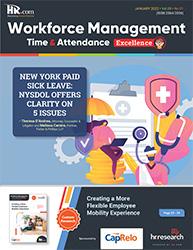
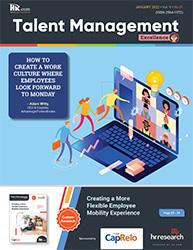
Informing, Educating, Enlightening and Assisting HR professionals in their personal and professional development, the Excellence series offers high-quality content through the publications!

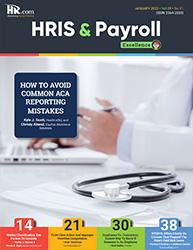



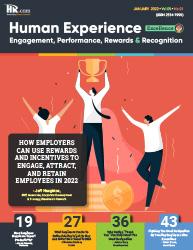





Like to submit an article? Use our online submission form or for more information go to www.hr.com/ExcellencePublications Publications


For more information: Phone: 1.877.472.6648 | Email: ePubeditors@hr.com | www.HR.com/epubs Talent Management Excellence October 2022

 - Brett Farmiloe, CEO & CHRO, Terkel.io
- Brett Farmiloe, CEO & CHRO, Terkel.io




















































 By Abbey Carlton, Indeed
By Abbey Carlton, Indeed





















 Izabella Mitchell, LightWork Software
Izabella Mitchell, LightWork Software
































 LEARN MORE
LEARN MORE



 LEARN MORE
LEARN MORE

 LEARN MORE
LEARN MORE














